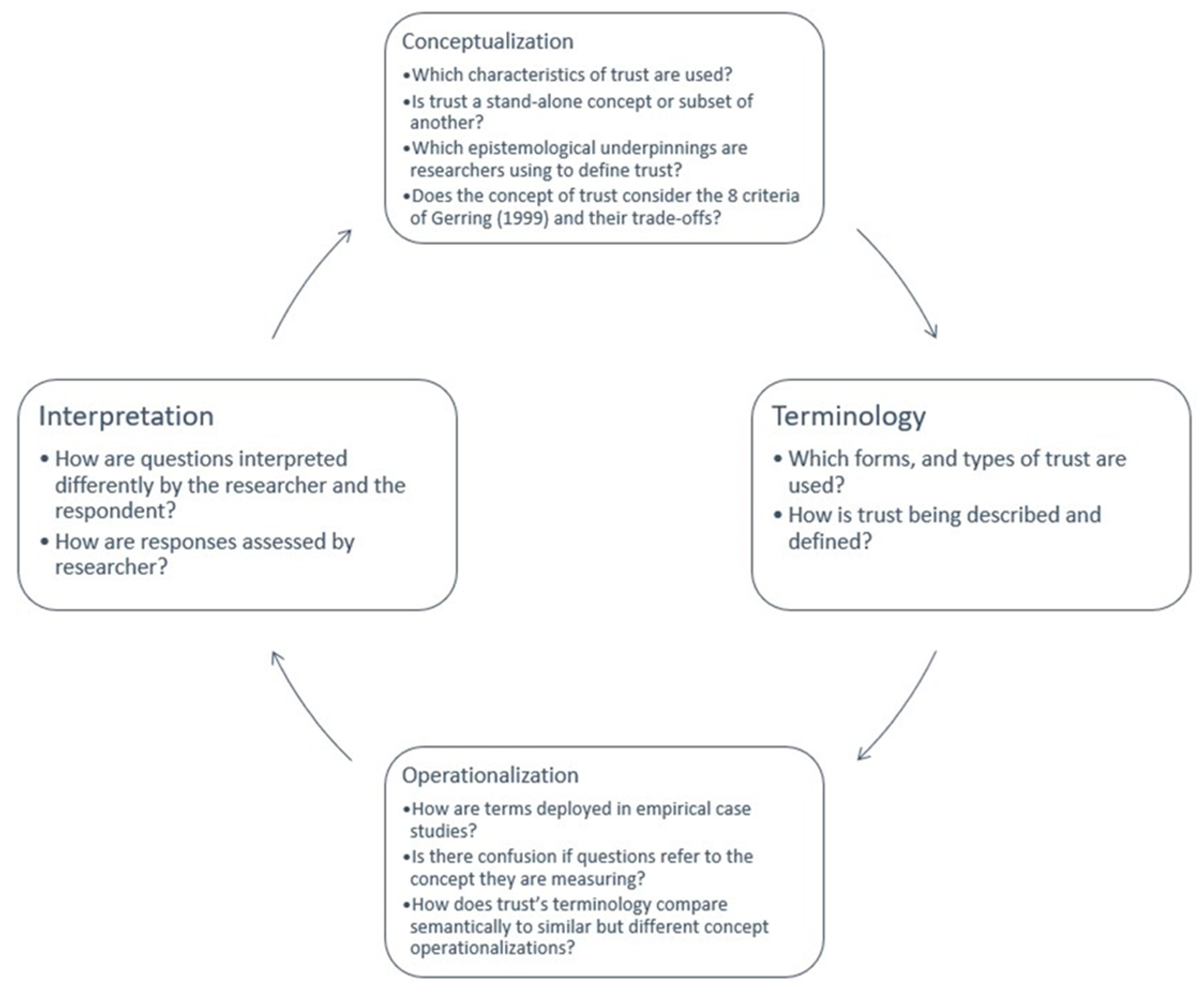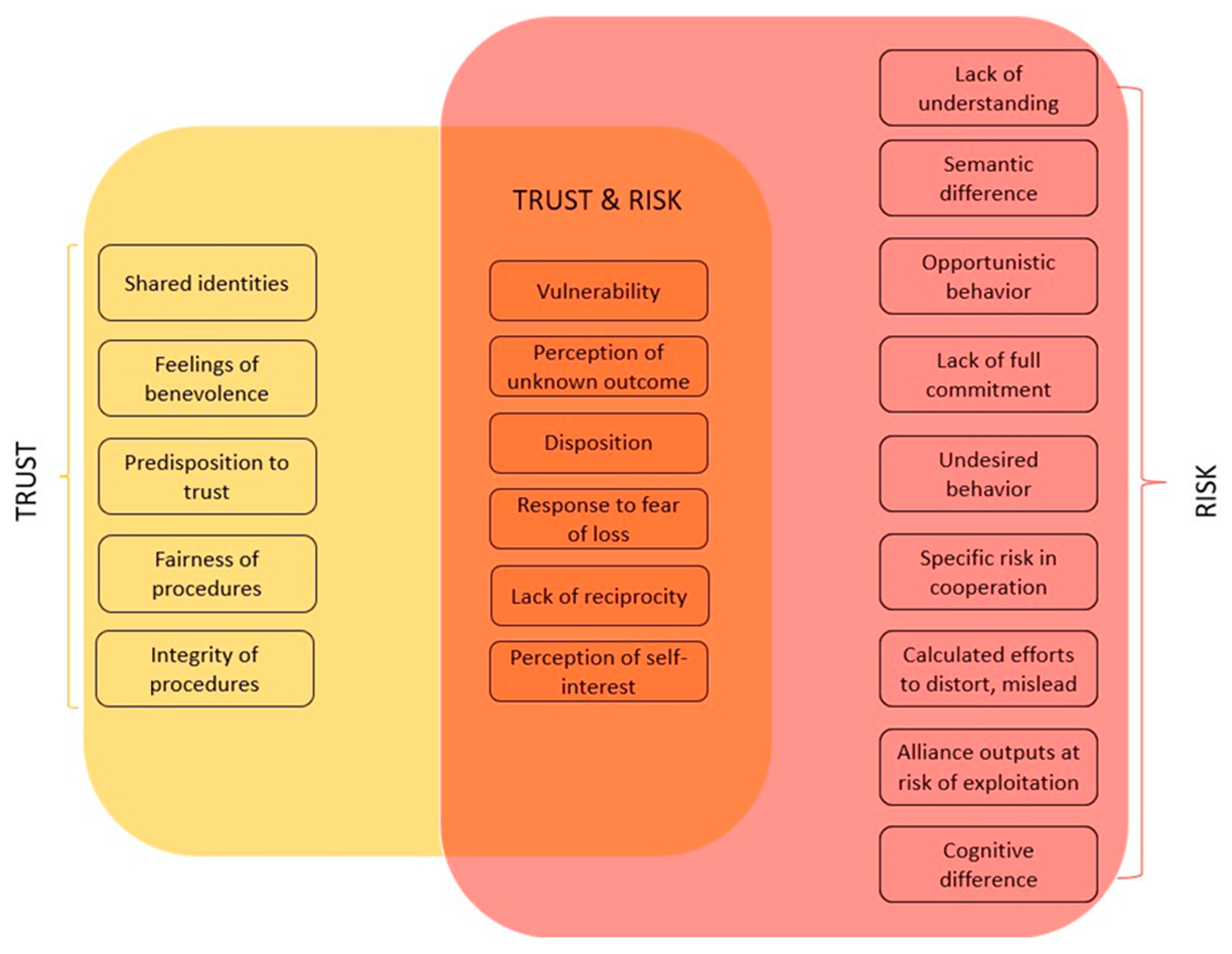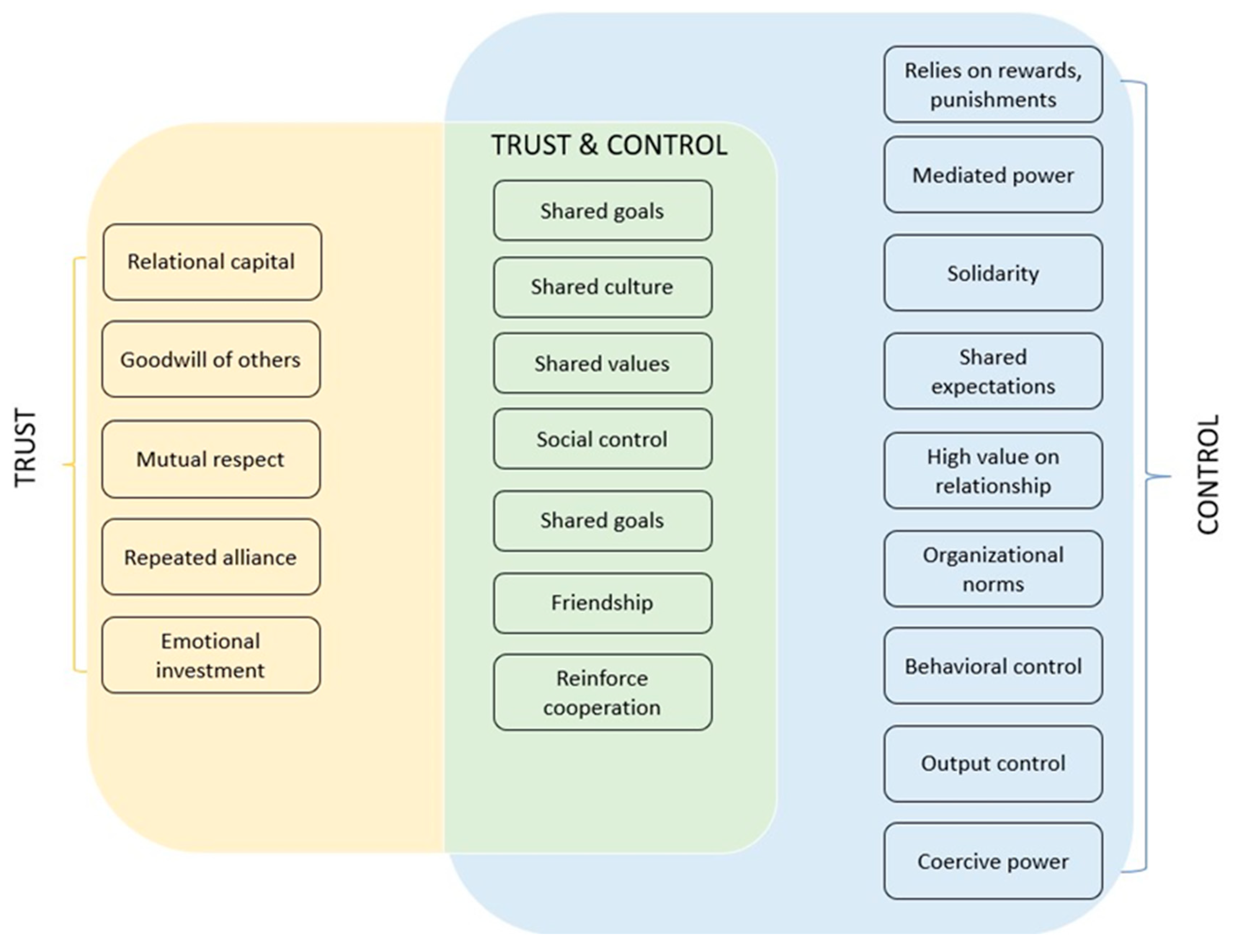Methodological Challenges in Studying Trust in Natural Resources Management
Abstract
:1. Introduction
2. Challenges to Measuring Trust in Natural Resources Management
2.1. Conceptualization
2.1.1. Concept Familiarity
2.1.2. Concept Differentiation
2.1.3. Trust over Time and Across Scales
2.2. Operationalization
3. Conclusions
Author Contributions
Funding
Acknowledgments
Conflicts of Interest
References
- Steger, C.; Gebrehiwot, K.; Chengere, S.A.; Marinkovich, J.; Dullo, B.W.; Zewde, S.W.; Klein, J.A. Mental models of a social-ecological system facilitate social learning among a diverse management team. Environ. Sci. Policy 2021, 122, 127–138. [Google Scholar] [CrossRef]
- Urcuqui-Bustamante, A.M.; Selfa, T.L.; Hirsch, P.; Ashcraft, C.M. Uncovering Stakeholder Participation in Payment for Hydrological Services (PHS) Program Decision Making in Mexico and Colombia. Sustainability 2021, 13, 8562. [Google Scholar] [CrossRef]
- Bots, P.W.G.; van Daalen, C.E. Participatory Model Construction and Model Use in Natural Resource Management: A Framework for Reflection. Syst. Pract. Action Res. 2008, 21, 389–407. [Google Scholar] [CrossRef] [Green Version]
- Österlin, C.; Schlyter, P.; Stjernquist, I. Different Worldviews as Impediments to Integrated Nature and Cultural Heritage Conservation Management: Experiences from Protected Areas in Northern Sweden. Sustainability 2020, 12, 3533. [Google Scholar] [CrossRef]
- LaMere, K.; Mäntyniemi, S.; Vanhatalo, J.; Haapasaari, P. Making the most of mental models: Advancing the methodology for mental model elicitation and documentation with expert stakeholders. Environ. Model. Softw. 2020, 124, 104589. [Google Scholar] [CrossRef]
- Ansell, C.; Gash, A. Collaborative Governance in Theory and Practice. J. Public Adm. Res. Theory 2007, 18, 543–571. [Google Scholar] [CrossRef] [Green Version]
- Medema, W.; Wals, A.; Adamowski, J. Multi-Loop Social Learning for Sustainable Land and Water Governance: Towards a Research Agenda on the Potential of Virtual Learning Platforms. NJAS-Wagening. J. Life Sci. 2014, 69, 23–38. [Google Scholar] [CrossRef] [Green Version]
- Ebel, S.A.; Beitl, C.M.; Runnebaum, J.; Alden, R.; Johnson, T.R. The power of participation: Challenges and opportunities for facilitating trust in cooperative fisheries research in the Maine lobster fishery. Mar. Policy 2018, 90, 47–54. [Google Scholar] [CrossRef]
- Feist, A.; Plummer, R.; Baird, J. The Inner-Workings of Collaboration in Environmental Management and Governance: A Systematic Mapping Review. Environ. Manag. 2020, 66, 801–815. [Google Scholar] [CrossRef] [PubMed]
- Gelcich, S.; Reyes-Mendy, F.; Rios, M.A. Early assessments of marine governance transformations: Insights and recommendations for implementing new fisheries management regimes. Ecol. Soc. 2019, 24, 12. [Google Scholar] [CrossRef] [Green Version]
- McLeod, C. Trust. In Stanford Encyclopedia of Philosophy; Edward, N.Z., Ed.; Stanford University: Stanford, CA, USA, 2020. [Google Scholar]
- Delerue, H. Relational risk perception and alliance management in French biotechnology SMEs. Eur. Bus. Rev. 2005, 17, 532–546. [Google Scholar] [CrossRef]
- Zhang, L.; Qian, Q. How mediated power affects opportunism in owner–contractor relationships: The role of risk perceptions. Int. J. Proj. Manag. 2017, 35, 516–529. [Google Scholar] [CrossRef]
- Stern, M.J.; Baird, T.D. Trust ecology and the resilience of natural resource management institutions. Ecol. Soc. 2015, 20. [Google Scholar] [CrossRef] [Green Version]
- Soliku, O.; Schraml, U. From conflict to collaboration: The contribution of comanagement in mitigating conflicts in Mole National Park, Ghana. Oryx 2020, 54, 483–494. [Google Scholar] [CrossRef] [Green Version]
- Hawley, K. Trust, distrust and commitment. Nous 2014, 48, 1–20. [Google Scholar] [CrossRef] [Green Version]
- de Fine Licht, K.; Brülde, B. On Defining “Reliance” and “Trust”: Purposes, Conditions of Adequacy, and New Definitions. Philosophia 2021, 1–21. [Google Scholar] [CrossRef]
- Baier, A. Trust and Antitrust. Ethics 1986, 96, 231–260. [Google Scholar] [CrossRef]
- Holton, R. Deciding to trust, coming to believe. Australas. J. Philos. 2006, 72, 63–76. [Google Scholar] [CrossRef]
- Das, T.K.; Teng, B.S. Trust, control, and risk in strategic alliances: An integrated framework. Organ. Stud. 2001, 22, 251–283. [Google Scholar] [CrossRef] [Green Version]
- Stern, M.J.; Coleman, K.J. The Multidimensionality of Trust: Applications in Collaborative Natural Resource Management. Soc. Nat. Resour. 2014, 28, 117–132. [Google Scholar] [CrossRef] [Green Version]
- de la Lama, R.L.; Valdés-Velasquez, A.; Huicho, L.; Morales, E.; Rivera-Ch, M. Exploring the building blocks of social capital in the Sechura Bay (Peru): Insights from Peruvian scallop (Argopecten purpuratus) aquaculture. Ocean. Coast. Manag. 2018, 165, 235–243. [Google Scholar] [CrossRef]
- Song, A.M.; Temby, O.; Kim, D.; Cisneros, A.S.; Hickey, G.M. Measuring, mapping and quantifying the effects of trust and informal communication on transboundary collaboration in the Great Lakes fisheries policy network. Glob. Environ. Chang. 2019, 54, 6–18. [Google Scholar] [CrossRef]
- Mayer, R.C.; Davis, J.H.; Schoorman, F.D. An Integrative Model of Organizational Trust. Acad. Manag. Rev. 1995, 20, 709. [Google Scholar] [CrossRef]
- Hotte, N.; Kozak, R.; Wyatt, S. How institutions shape trust during collective action: A case study of forest governance on Haida Gwaii. For. Policy Econ. 2019, 107, 101921. [Google Scholar] [CrossRef]
- Ray, B.; Mukherjee, P.; Bhattacharya, R.N. Attitudes and cooperation: Does gender matter in community-based forest management? Environ. Dev. Econ. 2017, 22, 594–623. [Google Scholar] [CrossRef]
- Brooks, C.M.; Crowder, L.B.; Österblom, H.; Strong, A.L. Reaching consensus for conserving the global commons: The case of the Ross Sea, Antarctica. Conserv. Lett. 2020, 13, e12676. [Google Scholar] [CrossRef]
- O’Leary, J.K.; Goodman, M.; Tuda, A.; Machumu, M.; West, L. Opportunities and challenges in achieving co-management in marine protected areas in East Africa: A comparative case study. J. Indian Ocean. Reg. 2020, 16, 317–347. [Google Scholar] [CrossRef]
- Cruickshank, A.; Notten, G.; Wesche, S.; Ballegooyen, K.; Pope, G. Co-management of traditional foods: Opportunities and limitations for food security in northern first nation communities. Arctic 2019, 72, 360–380. [Google Scholar] [CrossRef]
- Islam, M.M.; Nahiduzzaman, M.; Wahab, A. Fisheries co-management in hilsa shad sanctuaries of Bangladesh: Early experiences and implementation challenges. Mar. Policy 2020, 117, 103955. [Google Scholar] [CrossRef]
- McIntyre, K.B.; Schultz, C.A. Facilitating collaboration in forest management: Assessing the benefits of collaborative policy innovations. Land Use Policy 2020, 96, 104683. [Google Scholar] [CrossRef]
- Murunga, M.; Partelow, S.; Breckwoldt, A. Drivers of collective action and role of conflict in Kenyan fisheries co-management. World Dev. 2021, 141, 105413. [Google Scholar] [CrossRef]
- Hickey, G.M.; Snyder, H.T.; de Vries, J.R.; Temby, O. On inter-organizational trust, control and risk in transboundary fisheries governance. Mar. Policy 2021, 134, 104772. [Google Scholar] [CrossRef]
- Gerring, J. What makes a concept good? A criterial framework for understanding concept formation in the social sciences. Polity 1999, 31, 357–393. [Google Scholar] [CrossRef]
- Silva, M.R.O.; Pennino, M.G.; Lopes, P.F.M. Predicting potential compliance of small-scale fishers in Brazil: The need to increase trust to achieve fisheries management goals. J. Environ. Manag. 2021, 288, 112372. [Google Scholar] [CrossRef] [PubMed]
- McClenachan, L.; Scyphers, S.; Grabowski, J.H. Views from the dock: Warming waters, adaptation, and the future of Maine’s lobster fishery. Ambio 2019, 49, 144–155. [Google Scholar] [CrossRef]
- Kamiyama, R.; Miyata, T.; Ferrer, A.J.G.; Kurokura, H.; Ishikawa, S. Differences in the effects of social network, trust, and co-operation on fishery co-management. Mar. Policy 2018, 87, 314–320. [Google Scholar] [CrossRef]
- He, L.-Y.; Zhang, H.-Z. Spillover or crowding out? The effects of environmental regulation on residents’ willingness to pay for environmental protection. Nat. Hazards 2021, 105, 611–630. [Google Scholar] [CrossRef]
- McEvily, B.; Tortoriello, M. Measuring trust in organisational research: Review and recommendations. J. Trust Res. 2011, 1, 23–63. [Google Scholar] [CrossRef]
- Earle, T.C. Trust in Risk Management: A Model-Based Review of Empirical Research. Risk Anal. Int. J. 2010, 30, 541–574. [Google Scholar] [CrossRef]
- Hansson, S.O. Risk. In Stanford Encyclopedia of Philosophy; Edward, N.Z., Ed.; Stanford University: Stanford, CA, USA, 2018. [Google Scholar]
- Nooteboom, B.; Berger, H.; Noorderhaven, N.G. Effects of trust and governance on relational risk. Acad. Manag. J. 1997, 40, 308–338. [Google Scholar] [CrossRef] [Green Version]
- Delerue, H. Relational risks perception in European biotechnology alliances: The effects of contextual factors. Eur. Manag. J. 2004, 22, 546–556. [Google Scholar] [CrossRef]
- Zhang, L.Y.; Li, F. The impact of risk perception on developing incentive systems for relational contracting. KSCE J. Civ. Eng. 2015, 19, 1203–1213. [Google Scholar] [CrossRef]
- Heide, J.B.; John, G. Do Norms Matter in Marketing Relationships? J. Mark. 1992, 56, 32–44. [Google Scholar] [CrossRef]
- Lui, S.S.; Ngo, H.Y. The role of trust and contractual safeguards on cooperation in non-equity alliances. J. Manag. 2004, 30, 471–485. [Google Scholar] [CrossRef]
- Kale, P.; Singh, H.; Perlmutter, H. Learning and protection of proprietary assets in strategic alliances: Building relational capital. Strateg. Manag. J. 2000, 21, 217–237. [Google Scholar] [CrossRef]
- Brown, J.R.; Lusch, R.F.; Nicholson, C.Y. Power and relationship commitment: Their impact on marketing channel member performance. J. Retail. 1996, 71, 363–392. [Google Scholar] [CrossRef]
- Kim, K. On interfirm power, channel climate, and solidarity in industrial distributor-supplier dyads. J. Acad. Mark. Sci. 2000, 28, 388–405. [Google Scholar] [CrossRef]
- Nielsen, B.B. The role of trust in collaborative relationships: A multi-dimensional approach. Management 2004, 7, 239–256. [Google Scholar] [CrossRef] [Green Version]
- Serva, M.A.; Fuller, M.A.; Mayer, R.C. The reciprocal nature of trust: A longitudinal study of interacting teams. J. Organ. Behav. 2005, 26, 625–648. [Google Scholar] [CrossRef]
- Schweitzer, M.E.; Hershey, J.C.; Bradlow, E.T. Promises and lies: Restoring violated trust. Organ. Behav. Hum. Decis. Process. 2006, 101, 1–19. [Google Scholar] [CrossRef] [Green Version]
- de Vries, J.R.; Aarts, N.; Lokhorst, A.M.; Beunen, R.; Munnink, J.O. Trust related dynamics in contested land use: A longitudinal study towards trust and distrust in intergroup conflicts in the Baviaanskloof, South Africa. For. Policy Econ. 2015, 50, 302–310. [Google Scholar] [CrossRef]
- Nielsen, B.B. Multilevel Issues in Strategic Alliance Research. In Researching Strategic Alliances: Emerging Perspectives; Das, T.K., Ed.; Information Age Publishing, Inc.: Charlotte, NC, USA, 2010; pp. 1–26. [Google Scholar]
- Assche, K.; Van Beunen, R.; Duineveld, M. Evolutionary Governance Theory: An Introduction; Springer: Berlin/Heidelberg, Germany, 2014. [Google Scholar]
- Nescolarde-Selva, J.A.; Usó-Doménech, J.L.; Gash, H. Structure and superstructures in complex social systems. Systems 2017, 5, 28. [Google Scholar] [CrossRef] [Green Version]
- Hamm, J.A.; PytlikZillig, L.M.; Herian, M.N.; Tomkins, A.J.; Dietrich, H.; Michaels, S. Trust and intention to comply with a water allocation decision: The moderating roles of knowledge and consistency. Ecol. Soc. 2013, 18, 49. [Google Scholar] [CrossRef] [Green Version]
- PytlikZillig, L.M.; Kimbrough, C.D.; Shockley, E.; Neal, T.M.; Herian, M.N.; Hamm, J.A.; Bornstein, B.H.; Tomkins, A.J. A longitudinal and experimental study of the impact of knowledge on the bases of institutional trust. PLoS ONE 2017, 12, e0175387. [Google Scholar] [CrossRef]
- Voogd, R.; de Vries, J.R.; Beunen, R. Understanding public trust in water managers: Findings from the Netherlands. J. Environ. Manag. 2021, 300, 113749. [Google Scholar] [CrossRef] [PubMed]



| Concept | Statement | Type | Characteristic 1 | Characteristic 2 | Characteristic 3 | Characteristic 4 | Reference(s) |
|---|---|---|---|---|---|---|---|
| Trust | Because we have been working with this organization for so long, we can understand each other well and quickly | Affinitive Trust | Shared identities | Feelings of benevolence developed from longer-term interactions | [42] | ||
| Risk | Our partner expresses himself in a language which is close to ours | Incomprehension Risk | Lack of understanding | Semantic difference between partners | Cognitive difference between partners | [12,43] | |
| Trust | Most people would try to take advantage of you if they got the chance | Dispositional Trust | Stable personality trait signaling a predisposition to trust another entity | Individual’s propensity to trust others | [23] | ||
| Risk | We think that this owner will take advantage of us when the opportunity arises. | Relational risk perceptions | Opportunistic behavior | Probability that a partner does not fully commit to alliance in desired manner | Probability that a partner does not behave in a desired manner | Specific risk in cooperative behavior | [13,44] |
| Trust | People are almost always interested only in their own welfare | Dispositional Trust | Stable personality trait signaling a predisposition to trust another entity | Individual’s propensity to trust others | [23] | ||
| Risk | On occasion, we lie about certain things in order to protect our interests | Relational risk perceptions | Opportunistic behavior | Probability that a partner does not fully commit to alliance in desired manner | Probability that a partner does not behave in a desired manner | Specific risk in cooperative behavior | [13,44,45] |
| Trust | You can’t be too careful dealing with people | Dispositional Trust | Stable personality trait signaling a predisposition to trust another entity | Individual’s propensity to trust others | [23] | ||
| Risk | Complete honesty does not pay when dealing with our partner | Perception of opportunistic behavior | Outputs of alliance may not be well-defined, as a result, firms may risk opportunistic exploitation by their partner | Calculated efforts to mislead, distort, disagree, obfuscate, or otherwise confuse | [12,43] | ||
| Trust | In our experiences with this organization, we have never had the feeling of being misled | Procedural Trust | Fairness of procedures | Integrity of procedures | [42] | ||
| Risk | Our partner have always provided us a completely truthful picture of their business | Perception of opportunistic behavior | Outputs or profits of alliance may not be well-defined, as a result, firms may risk opportunistic exploitation by their partner | Calculated efforts to mislead, distort, disagree, obfuscate, or otherwise confuse | [12,43] |
| Concept | Statement | Construct | Characteristic 1 | Characteristic 2 | Characteristic 3 | Characteristic 4 | Characteristic 5 | Reference(s) |
|---|---|---|---|---|---|---|---|---|
| Trust | Members share the same value | Shared vision | Shared goals | Shared culture | Shared values | Hypothesized to reinforce cooperation | [44] | |
| Control | We chose this partner because our culture is compatible with his | Informal autonomous instruments of control | Shared goals | Shared culture | Shared values | Hypothesized to reinforce cooperation | Organizational norms | [12] |
| Trust | I feel that I can influence the fisheries management process | None identified | Social control | [36] | ||||
| Control | Our party has the ability to influence the common vision | Control ability | Behavioral control | Social control | Output control | [44] | ||
| Trust | The alliance is characterized by high reciprocity among the partners | Relational capital | Goodwill of others | Develops from repeated alliance with partners | Emotional investment in others | Friendship | Mutual respect | [12,43,47] |
| Control | We feel that by going along with this owner, we would be favored on other occasions | Mediated power | Relies on rewards/punishments, or legal/contract terms | Coercive power | [13,48] | |||
| Trust | There is close, personal interaction between the partner at multiple levels | Relational capital | Goodwill of others | Develops from repeated alliance with partners | Emotional investment in others | Friendship | Mutual respect | [7,12,43] |
| Control | We cooperate closely with this owner in the implementation process of this project | Solidarity | High value on relationship | Shared expectations | Shared values | Friendship | [13,49] | |
| Trust | The alliance is characterized by personal friendship between the partner at multiple levels | Relational capital | Friendship | Develops from repeated alliance with partners | Emotional investment in others | Goodwill of others | Mutual respect | [12,43,47] |
| Control | We have developed personal as well as business relationships with this owner | Solidarity | Friendship | Shared expectations | Shared values | High value on relationship | [13,49] |
Publisher’s Note: MDPI stays neutral with regard to jurisdictional claims in published maps and institutional affiliations. |
© 2021 by the authors. Licensee MDPI, Basel, Switzerland. This article is an open access article distributed under the terms and conditions of the Creative Commons Attribution (CC BY) license (https://creativecommons.org/licenses/by/4.0/).
Share and Cite
Sohns, A.; Hickey, G.M.; de Vries, J.R.; Temby, O. Methodological Challenges in Studying Trust in Natural Resources Management. Land 2021, 10, 1303. https://doi.org/10.3390/land10121303
Sohns A, Hickey GM, de Vries JR, Temby O. Methodological Challenges in Studying Trust in Natural Resources Management. Land. 2021; 10(12):1303. https://doi.org/10.3390/land10121303
Chicago/Turabian StyleSohns, Antonia, Gordon M. Hickey, Jasper R. de Vries, and Owen Temby. 2021. "Methodological Challenges in Studying Trust in Natural Resources Management" Land 10, no. 12: 1303. https://doi.org/10.3390/land10121303
APA StyleSohns, A., Hickey, G. M., de Vries, J. R., & Temby, O. (2021). Methodological Challenges in Studying Trust in Natural Resources Management. Land, 10(12), 1303. https://doi.org/10.3390/land10121303






